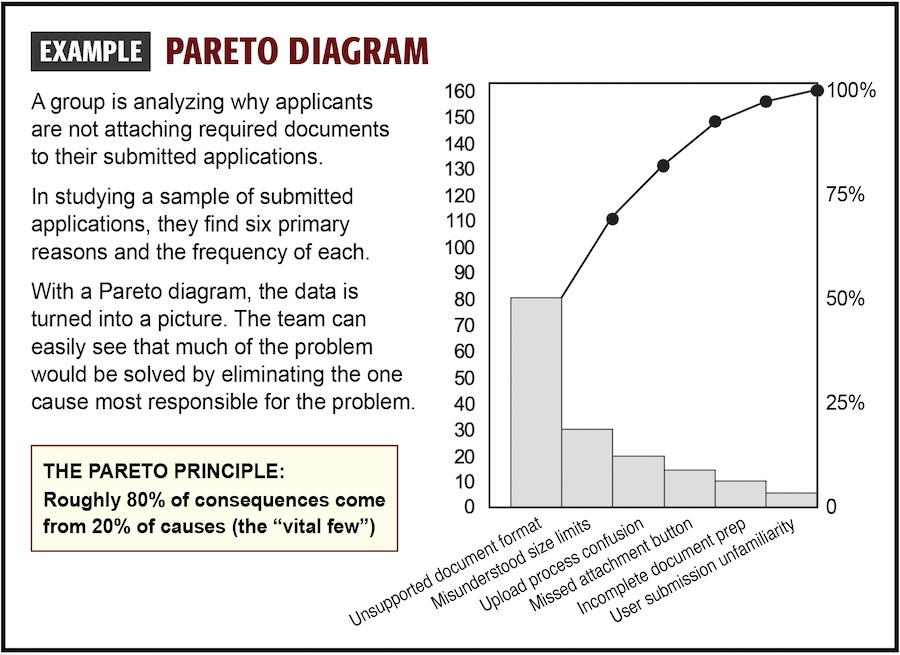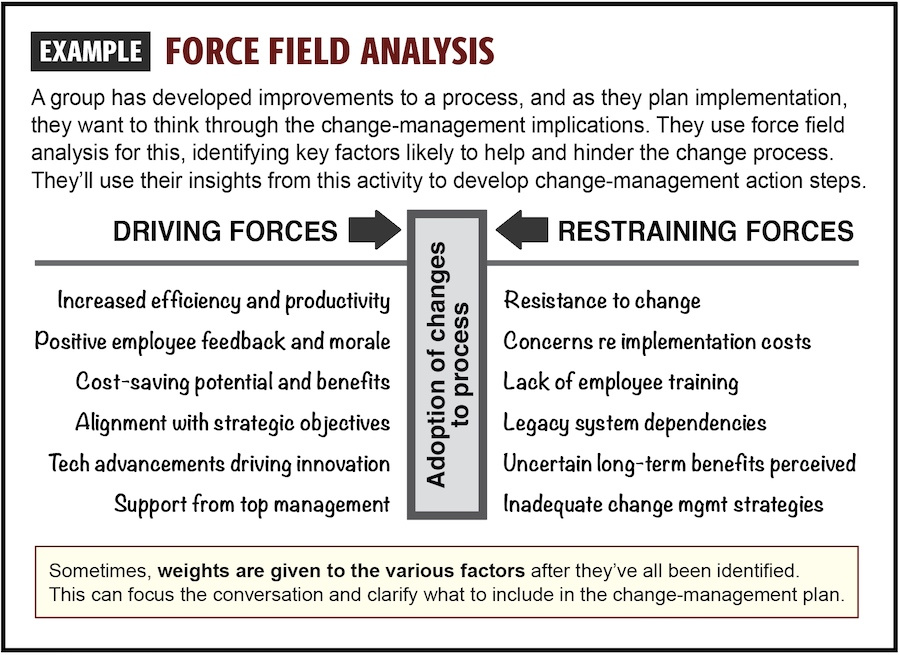Meeting Purpose: 
Click below for practical tips and tools.
Uncover one or two actions or approaches that you know will make better use of the meeting time and lead to a better outcome.
Ensure that the problem is clearly defined. An accurate and comprehensive problem statement is essential. Without it, a meeting can go in multiple inefficient directions.
Avoid jumping to solutions. It’s tempting to skips steps and cite a solution at the outset. But this “quicker” approach can lead to ineffective or temporary fixes that end up wasting time and solving nothing.
Dig deep to address causes. An analytical approach takes more time, but it helps groups pinpoint what needs to be solved – and keeps everyone from addressing surface-level symptoms or rushing to superficial solutions.
Bring in relevant information. Collect and review data, facts, and insights related to the problem and its causes. Encourage meeting-goers to share their perspectives, observations, and expertise to enrich the discussion.
Hear from stakeholders who are affected by the problem. They are a crucial source of input regarding impact, root causes, and potential solutions. Among the approaches to use: input sessions (with 3-5 stakeholders and five or so questions), one-on-one conversations (with a set of questions), and surveys.
Circulate key info to ensure understanding. If the solution involves a set of agreements and action steps or other key items, spell them out in a document that’s sent to all meeting participants.
The following agenda is a general example designed to serve as a starting point. Note that there are two agendas.
The percentages are approximate time allotments, to be adjusted based on specific needs or priorities for the meeting.
1. Introduction (5%)
- Review the purpose and intended outcomes of the meeting.
- Define the problem and stress the need to identify its root cause.
2. Identifying Symptoms vs. Root Causes (25%)
- Differentiate between symptoms and root causes.
- Discuss initial insights.
3. Root Cause Analysis (25%)
- Delve into understanding the core issue. (Consider using a structured method like the Why Technique.)
4. Solution Brainstorming (20%)
- Generate solutions specifically targeting the identified root cause(s).
5. Solution Evaluation (15%)
- Assess solutions based on effectiveness in addressing the root cause and feasibility.
- Choose and finalize the best-fit solution.
6. Action Plan (10%)
- Outline clear steps for implementation, assign responsibilities, and set realistic timelines.
To find effective solutions to problems, groups need to uncover root causes, then study these to see which one or two causes have the biggest, and then develop actions to eliminate or at least reduce those big causes. As this process unfolds, it helps immensely to write down and draw out key ideas and observations – because simply talking back and forth won't get you the clarity, understanding, and impact that are needed to keep the discussion moving forward.
If your meeting space has a whiteboard or flip chart, put it to work. If sticky notes are available, meeting-goers can use those to jot down ideas,. If you're in an online meeting, turn on screen share and use something like Microsoft Whiteboard or draw.io. Or prep a visual before the meeting and have it ready to share.
Root cause analysis is the process of uncovering and resolving the key underlying factors that contribute to a problem – versus simply addressing surface-level symptoms. Getting to the root of the problem is the surest way to bring about an effective and long-lasting solution.
Video: ![]() Using the 5-why technique to get to the root cause of a problem (2:02 min.)
Using the 5-why technique to get to the root cause of a problem (2:02 min.)
Step by step:
1. Define the problem: Clearly describe the issue you're facing and its impact or symptoms.
2. Ask why: Start by asking why the problem exists. Identify immediate reasons or factors contributing to it.
3. Dig deeper: For each reason you find, ask "why" again to uncover deeper causes or related issues. Then for each of those findings, ask "why" yet again. Keep doing this – asking why, why, why – in order to peel back the layers and get to root causes. (The 5-Why Technique is a commonly cited tool for root cause analysis. The name suggests five passes of asking why, but in practice, you might get to the root by asking why three or four times – or you might need to go beyond five.)
4. Collect information: Whenever possible, gather relevant data that can help the group better understand the nature and impact of emerging root causes that seem to have significant impact. For example, if the group theorizes that incomplete submissions are due to people not knowing what to submit or how to submit, a quick survey of submitters could explore this and get greater clarity. (See Pareto Diagram below.)
5. Find solutions: Once you've identified the one or two most significant root cause(s), move on to practical solutions or actions that can address them effectively.
6. Monitor and adjust: Implement your chosen solutions and keep an eye on how well they work. Adjust as needed to ensure the problem doesn't come back.
A Pareto diagram helps you discover which causes or issues are the biggest factors in giving rise to a problem. The name comes from the Pareto Principle, which states that roughly 80% of the effects come from 20% of the causes. The Pareto diagram is truly a visual tool – once the graph is created, the tallest bars show what is most contributing to the problem. This knowledge is essential to effective problem solving.
Video: ![]() Whiteboard demo of Pareto analysis (7 min.)
Whiteboard demo of Pareto analysis (7 min.)
Visual example:
Click to expand – will open in a new window
Note: A Pareto diagram is created in advance, typically with input from the group. The finished diagram is then shared and discussed at a meeting.
Step by step to create a Pareto diagram:
1. List the issues: Get clear on the problem that's being studied – then identify the likely contributing causes/factors to analyze with data. These can include defects, errors, complaints, costs, and so on. Also identify the appropriate unit of measure for each of these (such as number of frequency of occurrence impact).
2. Collect data: For a given time period, gather data on each of the causes. For example, if one of the causes is "submissions arrive with missing information," track and record the number and percentage of submissions where this occurs.
3. Rank the issues: Arrange the issues in descending order based on their frequency or impact, starting with the most significant problem at the top.
4. Calculate cumulative percentage: Calculate the cumulative percentage by adding up the percentages of each issue as you go down the list.
5. Plot the graph: Construct a graph by plotting the ranked issues along the horizontal axis (x-axis), and their respective frequencies or impacts along the vertical axis (y-axis). Also, include a line graph illustrating the cumulative percentages to show the cumulative impact or contribution of each issue.
6. During the meeting, review the graph and identify the vital few: Compare the frequency or other measure of each category relative to all the others. Identify the "vital few" issues that contribute to approximately 80% of the total problems or impacts.
7. Put it to work: To solve (or significantly reduce) the problem, address the one or two causes that are most responsible for the problem – instead of implementing a laundry-list of actions that may or may not have any real impact.
A3 problem solving is a structured approach for solving a well-defined workplace problem. The "A3" name is based on the paper size that was originally used to document all the problem-solving steps on one large page. You can use whatever size you want, on paper or on screen.
Video: ![]() Introduction to A3 Thinking (10:33 min.)
Introduction to A3 Thinking (10:33 min.)
Fill-save A3 templates:
Portrait format [pdf]
Landscape format [pdf]
Step by step:
1. Define the problem: At the top of the A3 sheet, clearly state the problem or issue you're addressing, and describe why it's important to solve.
2. Describe the evidence: Note what's being seen that indicates a problem. Include relevant data, observations, or evidence that highlights the extent and impact of the issue. Use facts, figures, or visual aids to illustrate the current state effectively.
3. Define goals: Clearly articulate what you aim to achieve and by when. Include intended outcomes – and also include specific, measurable targets or criteria that would signal resolution or improvement.
4. Uncover root causes: Conduct an analysis to explore the root causes contributing to the problem. On the A3, note the most likely root cause(s).
5. Develop and evaluate solutions: Develop solutions or interventions to address the root causes. Evaluate each solution based on its feasibility and impact (potential to resolve the problem effectively). Consider the pros and cons, resources required, timing, and anticipated outcomes of each proposed solution. After deciding, document these solutions (called "countermeasures" in A3 lingo) on the A3 template.
6. Plan the implementation: Develop an action plan outlining the specific steps, tasks, responsibilities, and timelines for implementing the chosen solutions. Define clear action items, assign responsibilities, and establish time frames.
7. Monitor progress: Implement the action plan and monitor outcomes and results. You need to know: Are the countermeasures having the intended impact?
8. Further improve: Use insights from periodic progress checks to determine what still needs to be done to further reduce or continue preventing the problem.
The Six Thinking Hats method, developed by Edward de Bono, is a structured technique that works well for problem-solving. The "hats" help people explore a problem (and its causes) from different angles, one angle at a time. The approach ensures very thorough thinking.
Videos:![]()
What Is the Six Thinking Hats approach? (1:58 min.)
Using the Six Thinking Hats (7:20 min.)
Step by step:
The hat is a metaphor that cues the group on what to think about. Participants "wear" one hat at a time, focusing their discussion accordingly.
There isn't a required order in which to use the Six Thinking Hats for problem solving., but the following sequence is sometimes recommended:
1. Blue Hat (Managing Hat): Start with the Blue Hat to set the agenda for problem-solving. Clearly define the problem, state the objectives, and establish the rules for the discussion. Ensure that everyone understands the focus of the problem-solving session.
2. White Hat (Factual Hat): Put on the White Hat to gather and present factual information about the problem. Explore data, facts, and any relevant information that contributes to a clear understanding of the situation. Identify what is known and unknown.
3. Red Hat (Emotional Hat): Switch to the Red Hat to express emotions and feelings related to the problem. Encourage participants to share their intuitive responses and personal reactions. This can provide insights into the emotional aspects of the problem.
4. Black Hat (Critical Hat): Move to the Black Hat to critically analyze the problem. Identify potential risks, drawbacks, and obstacles. Evaluate the weaknesses and challenges associated with the problem to gain a realistic perspective.
5. Yellow Hat (Positive Hat): Transition to the Yellow Hat to explore positive aspects and potential solutions. Focus on opportunities, strengths, and benefits associated with various approaches to solving the problem. This phase is about generating constructive ideas.
6. Green Hat (Creative Hat): Finally, put on the Green Hat to stimulate creativity and generate innovative solutions. Encourage participants to think outside the box, explore unconventional ideas, and brainstorm creative approaches to solving the problem.
Force Field Analysis isn't used for analyzing a problem or developing solutions, but it can be very important when thinking ahead to implementation of a solution. Groups can use it to uncover "driving" forces that are likely to be supportive of the changes that come with implementation, and "restraining" forces likely to hinder change.
In other words, force field analysis is a change-management tool. It helps groups be eyes wide open to the various forces likely to help and hurt the rollout of their solutions.
Video: ![]() Whiteboard demo of force field analysis (3:29 min.)
Whiteboard demo of force field analysis (3:29 min.)
Visual example:
Click to expand – will open in a new window
Step by step:
1.Define the changes: Clearly articulate the solution – and the key aspects of change that it will involve as implementation unfolds.
2. List the driving forces: Identify and list all the factors that are supportive and pushing toward the change.
3. List the restraining forces: Similarly, identify and list the factors or forces that are likely to hold back or oppose the change.
4. Assign weights: Assign a numerical value or weight to each "force" based on its likely strength or impact. This can be a subjective assessment, using a scale like 1 to 5, where 1 is weak and 5 is strong.
5. Evaluate the balance: Calculate the total scores for both driving and restraining forces. Compare the totals to evaluate the balance between the forces pushing for the change and those resisting it. A higher score for driving forces indicates a greater likelihood of success, while a higher score for restraining forces suggests challenges and resistance.
6. Develop strategies: Based on the findings, brainstorm strategies or actions to strengthen the driving forces and weaken or overcome the restraining forces. Build these into the implementation plan, to go with the actions already planned for implementing the solution.